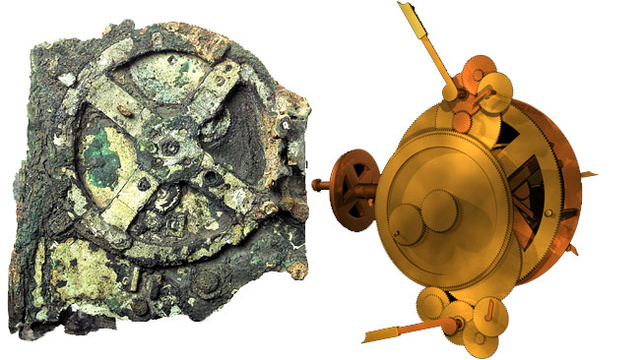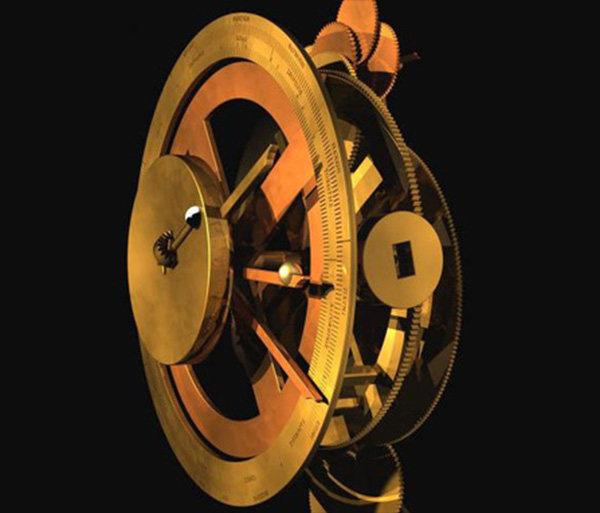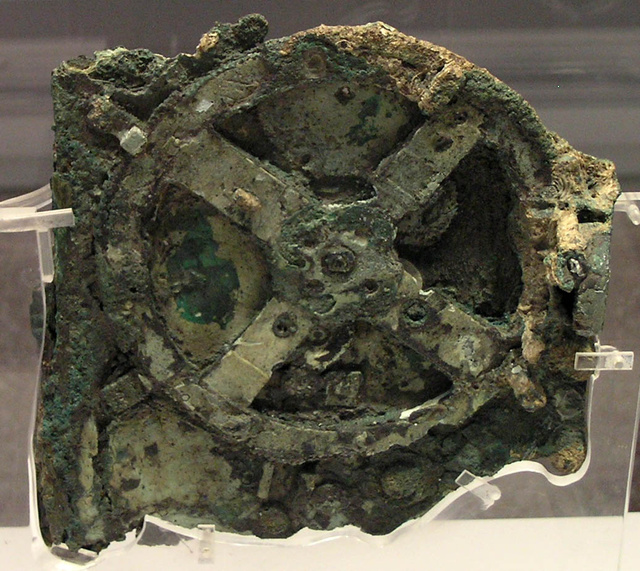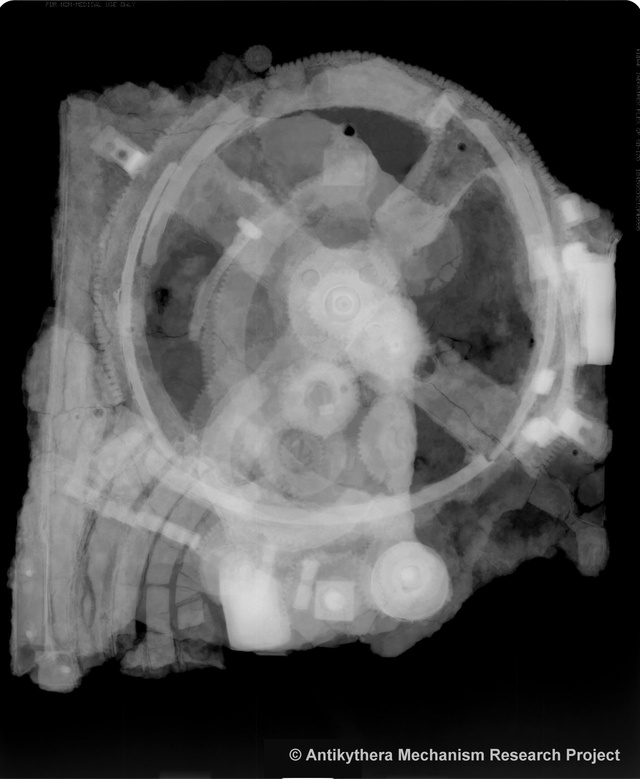Advanced Imaging Reveals An Ancient Computer Thousands Of Years Ahead Of Its Time. We Continue To Underestimate Our Ancestors
December 31, 2013
By Ed Grabianowski for io9

THE ANTIKYTHERA MECHANISM RESEARCH PROJECT
X-rays and advanced photography have uncovered the true complexity of the mysterious Antikythera mechanism, a device so astonishing that its discovery is like finding a functional Buick in medieval Europe.
In 1900, some divers found the wreck of a Roman vessel off the Greek island of Antikythera. Among the other treasures remanded to the Greek government was an unassuming corroded lump. Some time later, the lump fell apart, revealing a damaged machine of unknown purpose, with some large gears and many smaller cogs, plus a few engraved words in Greek. Early studies suggested it was some type of astronomical time-keeping device – researcher Derek J. de Solla Price laid the groundwork by establishing initial tooth counts and suggesting that the device followed the Metonic cycle, a 235-month pattern commonly used to predict eclipses in the ancient world.

THE ANTIKYTHERA MECHANISM RESEARCH PROJECT
The full function and beauty of the Antikythera device remained hidden until recent studies subjected it to more advanced imaging techniques. First, it was photographed using a technique that exposed the surfaces to varying lighting patterns. This created different levels of contrast that allowed the researchers to read far more of the inscribed Greek text than was previously possible. Then, x-ray imaging was used to create full 3-D computer models of the mechanism, which revealed for the first time some of the more complex and detailed gear interactions. The Greek National Archaeological Museum's discovery of some boxes filled with 82 additional mechanism fragments added new information as well.
The findings, published in Nature, are probably best described as "mind blowing." Devices with this level of complexity were not seen again for almost 1,500 years, and the Antikythera mechanism's compactness actually bests the later designs. Probably built around 150 B.C., the Antikythera mechanism can perform a number of functions just by turning a crank on the side.
Using nothing but an ingenious system of gears, the mechanism could be used to predict the month, day and hour of an eclipse, and even accounted for leap years. It could also predict the positions of the sun and moon against the zodiac, and has a gear train that turns a black and white stone to show the moon's phase on a given date. It is possible that it could also show the astronomical positions of the planets known to the ancients: Mercury, Venus, Mars, Jupiter and Saturn.

THE ANTIKYTHERA MECHANISM RESEARCH PROJECT
The Antikythera mechanism wasn't just a scientific tool – it also had a social purpose. The Greeks held major athletic competitions (such as the Olympics) every two or four years. A small dial within the Metonic dial showed the dates of these important events.
The true genius of the mechanism goes beyond even the complex calculations and craftsmanship of a mechanical calendar. For example, the ancients didn't know that the moon has an elliptical orbit, so they didn't know why it sometimes slowed or sped up as it moved through the zodiac. The mechanism's creator used epicyclic gears, also known as planetary gears, with a "pin-and-slot" mechanism that mimicked this apparent shifting in the moon's movement. This use of epicyclic gears is far ahead of what anyone suspected ancient technology was capable of. Scientific American has a two-part video about the mechanism and the imaging techniques used in the research.

THE ANTIKYTHERA MECHANISM RESEARCH PROJECT
The mystery of who built the Antikythera mechanism remains. It has been linked to renowned ancient inventor Archimedes by the writings of Cicero, but this particular device was built after Archimedes' death. Still, the engraved words revealed by the new photos pinpoint the device's origin to Corinth, or possibly Corinthian colonies. Sicily was such a colony, and the Sicilian city of Syracuse was Archimedes' headquarters. The researchers theorize that the Antikythera mechanism is based on an Archimedian design, and might even have been built by a workshop carrying on his technological tradition. But if the design has been "industrialized" in such a way, why have we never found another one like it? Mysteries remain.
The complexity of the mechanism shows that ancient humans were capable of intellectual and engineering feats that boggle our modern minds (and it puts the lie to all those "ancient astronaut" theories). The upheavals of war and natural disasters over 2,000 years have probably caused us to lose many more works and wonders that will never be found.
Click Here For The Most Popular On Sunny Skyz
 He Asked For Help Wrapping A Christmas Present — Then Surprised Her With A Life-Changing Gift
He Asked For Help Wrapping A Christmas Present — Then Surprised Her With A Life-Changing Gift
 The Funniest Wildlife Photos Of 2025 Are Here — And They’re Hilarious
The Funniest Wildlife Photos Of 2025 Are Here — And They’re Hilarious
 This 30-Year-Old’s Christmas Gift To His Mom Is Going Viral
This 30-Year-Old’s Christmas Gift To His Mom Is Going Viral
 A Couple Invited A Homeless Man In On Christmas — And He Never Left
A Couple Invited A Homeless Man In On Christmas — And He Never Left
 Police 'Arrest' A Lost Cat For 'Assault' — And She Has No Regrets
Police 'Arrest' A Lost Cat For 'Assault' — And She Has No Regrets
 Police Officer’s Simple Question Leads To An Unforgettable Christmas Moment
Police Officer’s Simple Question Leads To An Unforgettable Christmas Moment
 He Asked For Help Wrapping A Christmas Present — Then Surprised Her With A Life-Changing Gift
He Asked For Help Wrapping A Christmas Present — Then Surprised Her With A Life-Changing Gift
 This Teacher Found A Simple Way To Make Every Student Feel Loved
This Teacher Found A Simple Way To Make Every Student Feel Loved
 Beaver Casually Drags Branch Through Public Area While People Cheer
Beaver Casually Drags Branch Through Public Area While People Cheer
 90-Year-Old Grandma Gets Her Very First Doll On Christmas — The Tears Say It All
90-Year-Old Grandma Gets Her Very First Doll On Christmas — The Tears Say It All
 Coldplay's Chris Martin Surprises Couple At Wedding
Coldplay's Chris Martin Surprises Couple At Wedding
